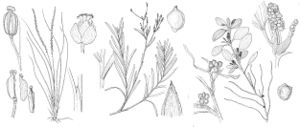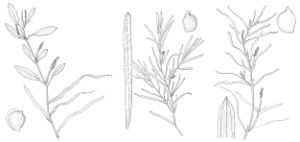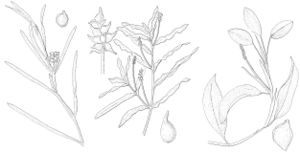Difference between revisions of "Potamogetonaceae"
FNA>Volume Importer |
imported>Volume Importer |
||
| (One intermediate revision by the same user not shown) | |||
| Line 79: | Line 79: | ||
|publication year= | |publication year= | ||
|special status= | |special status= | ||
| − | |source xml=https:// | + | |source xml=https://bitbucket.org/aafc-mbb/fna-data-curation/src/2e0870ddd59836b60bcf96646a41e87ea5a5943a/coarse_grained_fna_xml/V22/V22_592.xml |
}}<!-- | }}<!-- | ||
-->[[Category:Treatment]] | -->[[Category:Treatment]] | ||
Latest revision as of 20:32, 5 November 2020
Herbs, perennial or rarely annual, rhizomatous or not rhizomatous, caulescent; turions absent or present. Leaves alternate or nearly opposite, submersed or both submersed and floating, sessile or petiolate; sheath not persisting longer than blade, not leaving circular scar when shed, ligulate, not auriculate, or rarely auriculate; intravaginal squamules scales, more than 2. Inflorescences terminal or axillary, spikes, capitate spikes, or panicles of spikes, not subtended by spathe, pedunculate; peduncle not elongating, not spiraling following fertilization. Flowers bisexual; subtending bracts absent; tepals 4 in 1 series; stamens [2 or] 4, epitepalous, in 1 series; anthers distinct, dehiscing vertically; pollen spheric; pistils 1 or 4, mostly not stipitate, rarely short-stipitate; ovules marginal, orthotropous. Fruits drupaceous. Seeds 1; embryo curved.
Distribution
Nearly worldwide.
Discussion
The family has historically been considered to consist of two genera, Potamogeton and Groenlandia. Recent molecular evidence (D. H. Les, unpublished), combined with existing morphologic evidence, indicates that Potamogeton in the broad sense actually represents two separate lineages. We recognize those lineages at the generic level, Potamogeton in the strict sense and Stuckenia. Consequently, we accept three genera in the family, Potamogeton, Stuckenia, and Groenlandia.
Members of Potamogetonaceae have been variously combined with members of Zosteraceae, Cymodoceaceae, Zannichelliaceae, and Najadaceae to comprise compose Zosteraceae, Najadaceae, or Potamogetonaceae. Potamogetonaceae, as here interpreted, are separated from the other families by their bisexual flowers, the absence of spathelike bracts, and in some species, the presence of turions.
Aquatic vascular plants are known for their phenotypic plasticity (R. R. Haynes 1974). Plasticity may result from the varied environmental conditions in which the populations grow or from morphologic changes in individuals of a population during the growing season (R. R. Haynes 1975). Individuals in fruit have relatively consistent morphology within a species. Regardless of phenotypic plasticity, collections of Potamogetonaceae (and aquatic vascular plants in general) are often taken with little attention to the presence or absence of reproductive structures.
Reproductive features are most important in separating species of Potamogeton (R. R. Haynes 1978), and we include the entire family here. The keys may not always utilize reproductive features, but they are based on fruiting individuals. We strongly recommend that no one collect specimens of Potamogetonaceae that are lacking reproductive structures.
Leaves of Potamogetonaceae are stipulate. The stipules form a tubular sheath (stipular sheath) around the stem, free from or adnate to the base of the blade. In some species the leaf and sheath of submersed leaves are adnate for part of their length, and the leaf appears to have a sheathing base with an adaxial ligule at the junction of sheath and blade or petiole.
Fruits of Potamogetonaceae are drupaceous. The fruits do have endocarps but do not have fleshy mesocarps. Mesocarps exist but never become fleshy. Consequently, the fruits are not true drupes, they are drupaceous.
Many species of Potamogetonaceae undergo extensive vegetative reproduction either by turions or stem fragmentation. Turions are excellent modes of vegetative reproduction. The structures are produced at the stem tips and eventually fall to the substrate, either by a portion of the stem breaking off or by the stem itself falling to the substrate. The turions survive an unfavorable season, germinate, and grow into new plants during the next growing season. Because the unfavorable season is usually winter in North America, turions have been called "winter buds." At least one species, Potamogeton crispus, produces turions in early summer, and the turions survive the unfavorable season (summer, in this instance), germinating in the fall. The plant then survives the winter as a young individual, only a few centimeters long, even under ice, and begins growth as the water warms in the following spring. "Winter bud" is certainly not the correct term for P. crispus. The term "turions" designates all such structures, regardless of the unfavorable season.
Genera 3, species ca. 90 (2 genera, 37 species in the flora).
Selected References
Lower Taxa
Illustrations
Key
| 1 | Stipular sheaths of submersed leaves free from base of leaf blade, or if adnate, then adnate portion less than ½ length of stipule; leaves both submersed and floating or all submersed, submersed blades translucent, not channeled, flattened; peduncle stiff, if long enough then projecting inflorescence above surface of water. | Potamogeton |
| 1 | Stipular sheaths of submersed leaves adnate to base of leaf blade for 2/3 or more length of stipule; leaves all submersed, blades opaque, channeled, turgid; peduncle flexible, not projecting inflorescence above surface of water. | Stuckenia |


